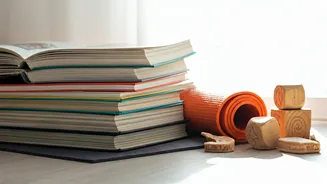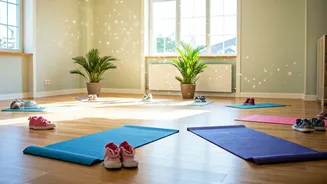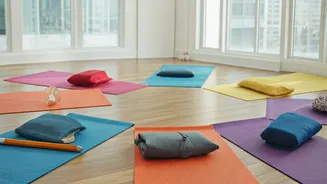Introduction to Yoga
Yoga offers numerous advantages for children, providing a fun and engaging way to improve their physical and mental health. The structured movements and breathing
exercises of yoga are not only beneficial for their bodies but also enhance focus, memory, and emotional regulation. Unlike strenuous workouts, these gentle exercises make yoga accessible for kids of all ages and abilities. Regular practice helps increase self-awareness and teaches kids how to manage stress and anxiety. It also serves as a relaxing activity, improving their overall physical and mental state. Introducing yoga early in life offers children vital skills for improved well-being.
Mountain Pose (Tadasana)
Tadasana, or Mountain Pose, forms the cornerstone of many yoga practices and is an excellent starting point for children. To perform this pose, instruct kids to stand tall with their feet firmly planted on the ground, either together or slightly apart. Ensure their weight is evenly distributed. They should lengthen their spine, stretch their arms downwards, and feel their fingers reach towards the floor. It aids in developing a sense of balance and bodily awareness. Mountain Pose boosts posture by encouraging kids to stand tall and straight. By maintaining this posture, children learn to feel grounded, enhancing their focus and steadiness, essential qualities for memory and concentration.
Tree Pose (Vrksasana)
Vrksasana, or Tree Pose, introduces balance and stability. To execute this pose, have kids stand upright, shift their weight onto one leg, and position the sole of the opposite foot on the inner thigh or calf of the standing leg, avoiding the knee joint. They should bring their hands together in front of their chest in a prayer position. Encourage them to find a spot to focus on, as this will assist them in maintaining balance. Tree Pose is wonderful for improving concentration as it compels children to stabilize their focus. The combined effect of physical balance and mental concentration significantly aids in enhancing memory and cognitive function. Regular practice helps children improve overall balance and build confidence.
Warrior II (Virabhadrasana II)
Warrior II, or Virabhadrasana II, enhances strength and stamina while improving focus. The stance requires kids to stand with their legs wide apart, with one foot turned outwards and the other foot turned inwards at a slight angle. The front knee should bend over the ankle, keeping the thigh parallel to the floor. Their arms should extend to the sides at shoulder height, gazing over the front hand. This pose cultivates both strength and determination. Warrior II enhances both physical and mental resilience. Its dynamic movement and steady focus boosts blood circulation and mental clarity. It's a great pose for improving focus and memory while supporting an energetic mental state.
Triangle Pose (Trikonasana)
Trikonasana, or Triangle Pose, helps stretch the sides of the body while increasing balance. To perform this, kids need to start with legs wide apart. They must reach one arm toward their foot and the other arm should extend upwards, keeping a straight line. They should gaze up at the raised hand, which opens the chest. This pose improves balance and coordination. It helps in the reduction of stress and promotes a feeling of mental clarity. The combination of stretching and focused attention can sharpen their mental abilities. This pose is particularly beneficial for kids by supporting both their physical and mental development.
Downward Dog (Adho Mukha Svanasana)
Adho Mukha Svanasana, commonly known as Downward-Facing Dog, is a highly beneficial pose for kids, offering a myriad of advantages. Children begin on their hands and knees, forming a table shape. They then lift their hips, forming an inverted 'V' shape with their body. The key is to keep the spine straight and the heels towards the ground. This pose enhances blood flow to the brain, which enhances focus and memory. It fosters flexibility and strength, promoting overall physical health. Downward Dog is particularly good for reducing stress and anxiety, creating a calmer mind, perfect for learning and memorization.
Cobra Pose (Bhujangasana)
Bhujangasana, or Cobra Pose, stretches the spine and opens the chest. Kids should lie on their stomach with their hands under their shoulders. They push up, using their arms to lift their chest off the floor, keeping their legs and hips on the ground. This pose enhances flexibility and boosts spinal strength. Cobra Pose improves mood by stimulating the brain, which enhances learning. It energizes the body, reduces fatigue, and strengthens the muscles in the back, ensuring overall better health. It can also help relieve stress and improve the circulation, making it a great posture for improving concentration.
Child's Pose (Balasana)
Balasana, or Child's Pose, provides a calming effect and offers a moment of rest. Children kneel, bring their forehead to the floor, and stretch their arms forward or place them alongside their body. The hips should rest on the heels. This pose allows for a peaceful break, reducing stress and anxiety. It supports the release of tension in the back and shoulders, encouraging relaxation. Child's Pose can enhance focus and improve mental clarity, which helps in better memory retention. Its soothing nature provides a perfect balance with the more active poses, offering both physical and mental benefits.
Seated Forward Bend (Paschimottanasana)
Paschimottanasana, or Seated Forward Bend, enhances flexibility and calms the mind. Kids sit with their legs stretched in front of them, reaching towards their toes while keeping their back straight. This pose helps improve blood flow to the brain, promoting better cognitive function. The forward bend provides a gentle stretch for the entire back, reducing tension, which promotes a feeling of peace. Regular practice can enhance concentration and memory retention. It can also improve the digestive system and boost energy levels. This pose is an excellent addition to the yoga routine as it promotes both physical and mental well-being.
Boat Pose (Paripurna Navasana)
Paripurna Navasana, or Boat Pose, strengthens the core and boosts mental focus. Kids sit with their knees bent and lift their feet off the ground, forming a 'V' shape with their body. They extend their arms forward, maintaining a straight back. It strengthens the core muscles. The focus on balance cultivates better concentration and memory skills. Boat Pose is an excellent pose for building mental strength and focus, helping children tackle academic challenges. Practicing this asana boosts both physical fitness and mental stability, ensuring that children can experience overall holistic growth.













